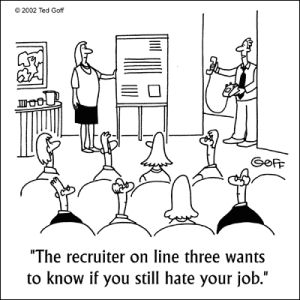 When was the last time you stepped away from the computer today? Do you regularly eat lunch at your desk? Have you been concentrating on one task for more than an hour and a half?
When was the last time you stepped away from the computer today? Do you regularly eat lunch at your desk? Have you been concentrating on one task for more than an hour and a half?
How you answer these simple questions will give you insights into how productive you are.
A RECENT ARTICLE in the New York Times drove home the importance of taking breaks throughout the day. In “Relax! You’ll Be More Productive” writer Tony Schwartz summarizes research that’s definitely relevant for the job seekers I work with, advise, and blog for (that’s you!). Here are a few key excerpts from the article:
Although many of us can’t increase the working hours in the day, we can measurably increase our energy. Science supplies a useful way to understand the forces at play here. Physicists understand energy as the capacity to do work. Like time, energy is finite; but unlike time, it is renewable. Taking more time off is counterintuitive for most of us. The idea is also at odds with the prevailing work ethic in most companies, where downtime is typically viewed as time wasted. More than one-third of employees, for example, eat lunch at their desks on a regular basis. More than 50 percent assume they’ll work during their vacations.
As athletes understand especially well, the greater the performance demand, the greater the need for renewal. When we’re under pressure, however, most of us experience the opposite impulse: to push harder rather than rest. This may explain why a recent survey by Harris Interactive found that Americans left an average of 9.2 vacation days unused in 2012 — up from 6.2 days in 2011.
The importance of restoration is rooted in our physiology. Human beings aren’t designed to expend energy continuously. Rather, we’re meant to pulse between spending and recovering energy.
Working in 90-minute intervals turns out to be a prescription for maximizing productivity. Professor K. Anders Ericsson and his colleagues at Florida State University have studied elite performers, including musicians, athletes, actors and chess players.
In each of these fields, Dr. Ericsson found that the best performers typically practice in uninterrupted sessions that last no more than 90 minutes. They begin in the morning, take a break between sessions, and rarely work for more than four and a half hours in any given day. Write that down and post it where you’ll see it!
Whether you are presently employed and looking for a better job in your precious spare time, or you’re unemployed and your job search is your full-time job, try taking short breaks every 90 minutes.
HERE ARE SOME suggested techniques for waking up your mind and body when you have extended hours of desk work to do.
Give your head a 1-minute mini-massage. Just tapping your skull and pulling on your earlobes gets the blood flowing.
Stand up and stretch. Not just once, but in all directions. Bend over, twist in place, do knee bends, raise your arms, and do push ups off the wall. Your back will love you if you do it gently.
Take a walk, preferably outside. Even if you walk in circles (large enough so you don’t get dizzy) by the back door, a little fresh air and movement does wonders.
Breath deeply. I mean really deeply. Inhale until your lungs can’t hold anymore, hold for one second, exhale, hold for one second, and repeat. Holding the breath on the exhale and inhale will prevent hyperventilating. Go slow. You’d be surprised how much air exchange can do to wake up your mind.
Do something different and relaxing. Particularly if you are problem-solving or breaking through creative barriers, clearing your mind by totally forgetting the task at hand and then returning to it gives you a new perspective. So, pick up your knitting, go for a run, pull some weeds, read something funny, small talk with a favorite co-worker, anything that puts your mind in a different place.
I’M ADDING small changes like these into my own work life. They’re easy and fun, and they really work. How about you? You in?
Want more details about this research? Read the full article here.
[photo source: powhealthandwellness.com]


 If you’ve decided that you want to work with a recruiter, your next question will probably be, “How do I get my resume in front of a recruiter?”
If you’ve decided that you want to work with a recruiter, your next question will probably be, “How do I get my resume in front of a recruiter?”




 When you’re looking for a job, sooner or later you may toy with the idea of working with a recruiting company. So, let’s get a handle on how the recruiting industry works.
When you’re looking for a job, sooner or later you may toy with the idea of working with a recruiting company. So, let’s get a handle on how the recruiting industry works.
 This website was created for the U.S. Department of Labor/Employment and Training Administration by the National Center for O*NET Development. The O*NET program is “the nation’s primary source of occupational information,” according to the site. It contains information on hundreds of occupations.
This website was created for the U.S. Department of Labor/Employment and Training Administration by the National Center for O*NET Development. The O*NET program is “the nation’s primary source of occupational information,” according to the site. It contains information on hundreds of occupations.
 Include how you know the person so that the person checking the reference has some context as to who this person is to you and what information they can supply.
Include how you know the person so that the person checking the reference has some context as to who this person is to you and what information they can supply. The Human Resources folks like to check job applicants’ references. Of American companies, 76% will contact the people on your list of references.
The Human Resources folks like to check job applicants’ references. Of American companies, 76% will contact the people on your list of references.